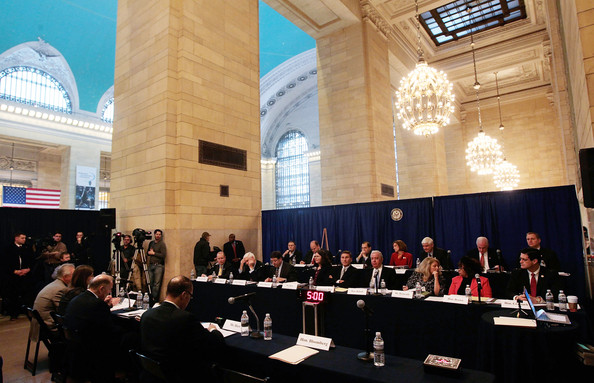
Sitting beneath the famous zodiac mural of Grand Central's main concourse, with the rumble of commuters and trains in the background, the House Transportation and Infrastructure Committee held its first field hearing of the new session this morning. The topic was the future of high-speed rail on the Northeast Corridor.
Chairman John Mica led the committee's Republicans towards what appears to be their emerging message on high-speed rail: they're for it, so long as it's built through public-private partnerships and largely limited to the dense Boston-Washington corridor.
High-speed rail advocates and some Democrats seem to think the re-prioritization of the Northeast Corridor could be a good thing, though other Democrats remain committed to the Obama administration vision of a nationwide network. Disagreements over the proper roles of the public and private sectors, however, were somewhat more partisan and contentious.
The call to prioritize the Northeast Corridor -- and therefore to stop spreading high speed rail dollars across the nation -- earned support from across the political spectrum in the hearing, perhaps not surprising given the heavy representation of northeastern representatives.
Pennsylvania Republican Bill Shuster, who chairs the Railroads Subcommittee, called himself a strong rail supporter but attacked the Obama administration's strategy so far. "There's no better way to move large numbers of people than passenger rail and high-speed rail," he said, telling the story of how improved service on Pennsylvania's Keystone corridor had convinced him to ride the rails instead of driving. But, he continued, Obama "took that stimulus money and spread it too thinly across the nation." He said that the President's State of the Union promise to bring high-speed rail to 80 percent of Americans by 2036 was simply unrealistic and that starting on the Northeast Corridor would be smarter.
Across the aisle, New York City Representative Jerry Nadler agreed that high-speed rail spending shouldn't be too diffuse, though he didn't specifically criticize past administration spending. Americans need to be able to see something for their money, he argued.
Former Pennsylvania Governor Ed Rendell and New York City Mayor Michael Bloomberg, both witnesses at the hearing in their positions as co-chairs of the infrastructure advocacy organization Building America's Future, agreed that future rail dollars needed to be more narrowly targeted. "We need to get real," said Rendell. "The way we're doing high-speed rail right now in America will amount to nothing." The small amount that his state received, he argued, "was done just to say that we gave Pennsylvania some money, so that Senator Specter and Casey can't be too mad." (The rail dollars were allocated while Arlen Specter was still in office and before he was replaced by arch-conservative Pat Toomey, who is against federal funding for high-speed rail.)
Not everyone agreed that focusing on a few routes, and the Northeast Corridor in particular, makes sense, however. Ranking member Nick Rahall said in his opening statement that a national rail network ought to remain the focus. "After all," the West Virginia Democrat said," it was a national vision that led to the creation of the world's most advanced highway and aviation networks."
While there is surely a regional divide at work, it wasn't a pure split. Ohio Republican Bob Gibbs praised his state's new governor for killing its high-speed rail program but said that it might make more sense in the northeast, where air traffic is snarled with congestion and transit already feeds into rail stations.
Building a high-speed rail line along the Northeast Corridor carries some particular challenges. First, the lack of an environmental impact statement has stalled improvements so far, according to Petra Todorovich of America 2050. That spurred calls from some committee Republicans, including Highways and Transit Subcommittee Chair John Duncan (R-TN), to ease environmental laws.
High-speed rail advocates seemed open to at least speeding up the environmental review process. Todorovich said her group is asking Transportation Secretary Ray LaHood to expedite an EIS for the corridor. Rendell agreed that the slow speed of the process will "drive you crazy" and suggested it could be faster.
Additionally, building high-speed rail through eight different states and the District of Columbia requires a high level of political coordination. Todorovich suggested the creation of a new public authority to cross state lanes.
Even as the committee debated where to prioritize high-speed rail, it also tackled the question of how and by whom it should be built. Although Amtrak has a $117 billion plan to build true high-speed rail along the Northeast Corridor by 2040, Mica said that "Amtrak will never be capable of developing the corridor to its full potential." The complex challenges of building the route, he said, "can only be addressed with the help of private sector expertise."
Rahall, in contrast, defended Amtrak, which he called "one of America's greatest assets." Only now, with increased funding over the last two years, is Amtrak financially stable enough to turn its attention to the kind of big ideas included in its Northeast Corridor Plan.
Rep. Corrine Brown, the Florida Democrat who serves as ranking member on the Railroads Subcommittee, tried to focus attention on Amtrak's chronic underfunding. "We've invested a lot of money in the highway system: $1.3 trillion," said Brown. "Just $6 billion or $7 billion in passenger rail." And under Bush, she said, "every budget that arrived to Congress was zeroed out for Amtrak."
Of course, the debates over public-private partnerships and over prioritizing the Northeast Corridor can't be completely separated. Because the Northeast Corridor already turns a profit and has a large ridership, said United State High Speed Rail Association VP Thomas Hart, it's the route most attractive to the private sector.





